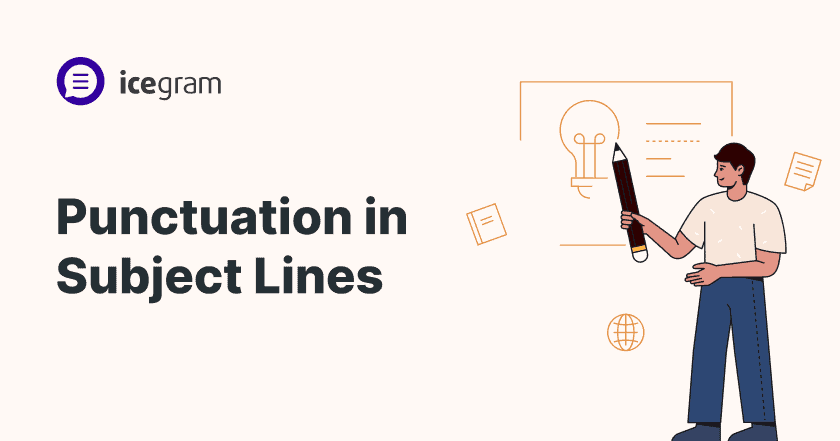The inbox. A battlefield where your meticulously crafted email wages war for mere seconds of attention. The first line of defense? Your subject line. It’s your war cry and it all hinges on a delicate dance with the punctuation in subject lines.
A well-placed question mark can spark curiosity, a strategic exclamation point can ignite urgency, and even a humble period can add an air of intrigue. But stride carefully, the battlefield is littered with punctuation hazards. Overstep those bounds, and your message may be expatriated to the treacherous spam purgatory.
So, fine-tune your quill, fellow wordsmith, and prepare to master the art of punctuation in subject lines. Let’s make your emails not just seen, but opened, read, and adored.
Tips for punctuation in subject lines
The ultimate key to punctuation in subject lines is balance and strategy. On one hand, the right punctuation can grab attention and spark interest whereas overdoing the same can have the opposite effect as well. Effective subject lines are the key to hooking subscribers.
Here’s a breakdown of what to use and avoid for punctuation in subject lines:
What to use sparingly
- Periods: Surprisingly, periods are still debated. Some think they’re unnecessary, while others believe they make subject lines stand out. Use them sparingly (2-4% of the time) for a deliberate, titillating effect.
- Question marks: These pique curiosity and prompt the reader to want an answer. But overuse can feel gimmicky or manipulative.
- Exclamation points: They deliver excitement or urgency, but too many can scream “spam” or come across as insincere. Use them thoughtfully and with care for important offers or updates.
- Ellipsis: This perplexing warrior hints at hidden secrets, incomplete stories, and untold possibilities. Three dots (…) can leave readers hanging in a delicious dilemma, but beware of leaving them dangling for too long, or they might lose interest.
- Dash: This quick, decisive punctuation focuses on action and direction. A “Limited time offer – 24 hours only!” can drive quick and swift action. But you must use it sparingly, as overuse can make your message feel choppy and breathless.
- Comma: This versatile one offers pause, clarifies relationships, and distinguishes key elements. A “Tips for Writers, Editors, and Designers” transparently identifies the target audience. Use commas skillfully to avoid ambiguity and confusion.
- Colon: This formal knight introduces an explanation, elaboration, or list. A “Subject: Important Updates: Website Redesign, New Features, Exclusive Discounts” delivers a concise and organized breakdown. But don’t overdress your colon; keep it for formal communications.
What to avoid
- Multiple punctuation marks: A cluttered subject line is hard to read and unprofessional. Stick to one or two at most.
- All caps: This screams SHOUTING and risks sending your email straight to spam.
- Excessive emojis or special characters: These can also trigger spam filters and look unprofessional. Use them only if they naturally fit your brand voice and audience. Keep emojis relevant to your brand and audience. A single well-chosen emoji can enhance your message, but remember, less is more.
- Don’t double down on emphasis: One exclamation point is enough to convey excitement, two or more start screaming spam. “Amazing Deal!!!” becomes just plain annoying.
- Symbols: Symbols like $, %, &, #, and * can trigger spam filters, especially when used excessively. “Get 50% OFF with code #SECRET2023!” might get caught before ever reaching its destination. Stick to standard punctuation and use special characters only if they naturally fit your brand voice and audience.
- Avoid fallacious or deceptive language in your subject lines: “You won’t believe what it caused next!” might spark curiosity, but if the email content doesn’t match, you’ll lose the trust of your audience.
- Be honest and clear in your subject lines: “Learn Top Recommended Tips for 2024 Success” is clear and relevant, while “Secret Method to Make Millions Online” reeks of false news.
Remember, the goal of your subject line is to encourage not just opening up but drawing attention without resorting to spammy tactics. Build trust with your audience by using punctuation deliberately and ethically. Any mistake can kill your email click-through rates.
General tips
- Test different formats: See what resonates with your audience by A/B testing different subject lines with punctuation variations.
- Match your tone: Tailor your punctuation to the content and mood of your email. A casual update might warrant a question mark, while a formal announcement might be better served with a period.
- Clarity first: Regardless of punctuation, prioritize clarity and conciseness. The recipient should immediately understand what your email is about.
Remember, the ultimate goal is to capture attention and encourage opens without being gimmicky or triggering spam filters. Use punctuation strategically and keep your audience in mind for the best results. And for crafting better engagement emails you can always reach out to Icegram Express.
Conclusion
The combat zone of the inbox demands strategic minds and acrobatic fingertips. In this, punctuation in subject lines is your secret weapon, capable of sparking curiosity, igniting urgency, and guiding your email to its glorious destination. Remember, the key lies in the balance. Always embrace the power of accuracy by using punctuation in subject lines intentionally, tailoring it to your audience, tone, and desired action. Beware the spam swamp and steer clear of excessive emphasis, all caps, emoji explosions, and special character specters. Go ahead and let your subject lines shine!

